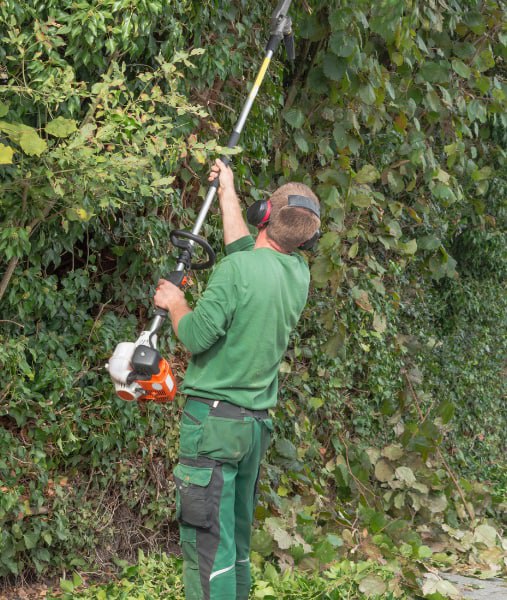Tree stumps left behind after tree removal can be more than just an eyesore—they can pose risks to your garden’s health and safety. Understanding whether a stump is rotting and requires removal is crucial for maintaining the overall well-being of your outdoor space. At Dover Tree Surgery, we help homeowners in Dover, Kent, identify and safely remove rotting stumps, ensuring their gardens remain healthy and hazard-free. Here’s how you can tell if a stump is decaying and why professional removal might be necessary.
Signs That a Tree Stump Is Rotting
Recognising the early signs of a rotting stump can help prevent further issues. Here are the key indicators that your tree stump may be deteriorating:
- Mushroom and Fungal Growth: One of the most visible signs of a decaying stump is the presence of fungi. If you notice mushrooms or other fungal growth around the base of the stump, this is a clear indication that decay is setting in. Fungi thrive in moist, decomposing wood, making their presence a reliable sign of a rotting stump.
- Soft or Spongy Wood: Healthy wood is firm to the touch, whereas rotting wood often becomes soft and spongy. Pressing on different parts of the stump can reveal areas that have softened due to decay. These sections may crumble easily under pressure, signalling that the decomposition process is well underway.
- Unpleasant Odour: As wood decays, it can emit a distinct, unpleasant smell. This musty or sour odour is a byproduct of the fungi and bacteria breaking down the wood. If you notice an unusual smell coming from the stump, it’s a sign that decay has progressed beneath the surface.
- Insects and Pests: Rotting stumps often attract insects such as beetles, ants, and termites. While some insects may naturally inhabit tree stumps, a large or increasing number of pests could indicate that the stump is decaying and becoming a habitat for unwanted critters.
Why a Rotting Stump Should Be Removed
While it may seem harmless to leave a stump in place, a rotting stump can lead to a range of problems for your garden. Here’s why timely removal is essential:
- Prevention of Pest Infestations: As mentioned, rotting stumps attract various insects, including termites and carpenter ants. If left unchecked, these pests can spread to nearby plants, trees, and even your home’s wooden structures, causing damage that can be costly to repair.
- Spread of Fungal Diseases: The fungi that thrive in decaying wood can sometimes spread to healthy trees and plants nearby. This can lead to diseases that weaken or kill otherwise healthy vegetation in your garden. Removing a rotting stump can help protect the health of your other trees and shrubs.
- Safety Concerns: A decaying stump can become unstable, posing a tripping hazard, especially for children or visitors. Additionally, the roots of the stump may become exposed as the stump breaks down, creating further hazards. Removing the stump ensures a safer outdoor environment.
- Aesthetic Improvement: Beyond the practical concerns, removing a rotting stump can greatly enhance the appearance of your garden. A decaying stump can detract from the overall look of your outdoor space, whereas a clean, stump-free garden can look more polished and inviting.
Professional Stump Removal: What to Expect
If you’ve identified a rotting stump in your garden, the next step is to consider professional removal. At Dover Tree Surgery, we offer safe and efficient stump removal services tailored to the needs of homeowners in Dover, Kent. Here’s what you can expect when opting for professional stump removal:
- Stump Grinding: One of the most effective methods of stump removal is stump grinding. This process involves using a specialised machine to grind the stump down to below ground level, effectively eliminating the visible part of the stump. Stump grinding is ideal for larger stumps and ensures that the area can be replanted or landscaped afterwards.
- Complete Stump Removal: For those who want the entire stump, including the roots, removed, complete stump extraction is an option. This process is more involved than grinding but ensures that no roots are left behind to interfere with future planting or landscaping projects.
- Consultation and Assessment: At Dover Tree Surgery, we provide a thorough assessment of the stump’s condition before recommending the best course of action. Our team considers factors such as the stump’s size, location, and degree of decay to determine the most effective removal method.
Conclusion: Don’t Let a Rotting Stump Become a Problem
Leaving a decaying stump in your garden can lead to a host of issues, from pest infestations to safety hazards. Recognising the signs of rot early and opting for professional removal can protect your garden’s health and maintain a tidy, safe outdoor space. At Dover Tree Surgery, we are committed to providing expert stump removal services for homeowners in Dover, Kent, ensuring that every garden looks its best and remains free of unwanted hazards.
If you suspect a stump in your garden is rotting or simply want to improve the appearance of your outdoor space, contact Dover Tree Surgery today. Our skilled team is here to provide professional advice and efficient stump removal services, helping you create a healthier, more beautiful garden. Don’t wait until the problem worsens—let us help you reclaim your outdoor space.
Call us on: 01304 796896
Click here to find out more about Dover Tree Surgery
Click here to complete our contact form and see how we can help with your tree’s needs.
